

Move your mouse over the picture to see the names of the various features.
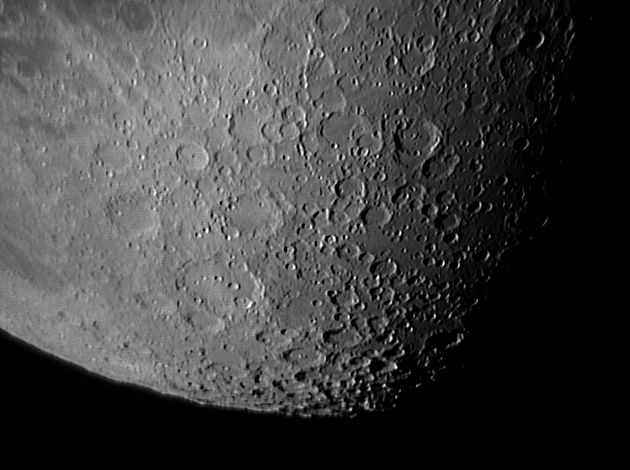
A wide-angle picture of the south-polar area. A larger mosaic of part of this
area can be found here.
I have made no effort to show scale markers on this picture. They would hardly be
meaningful (see below).
The picture was taken with a ToUcam attached to my LX200 on 23rd September 2005 at 03:26 UT,
when the Moon was 20.1 days old.
Date and Time: 23rd September 2005 at 03:26 UT
Camera: ToUcam 740K
Telescope: LX200 with 0.33 focal reducer and IR-pass filter
Capture: K3CCDTools. Low gamma, 1/33", 22% gain, 304 frames
Processing: Registax. 45 frames stacked. Wavelet 1 = 10
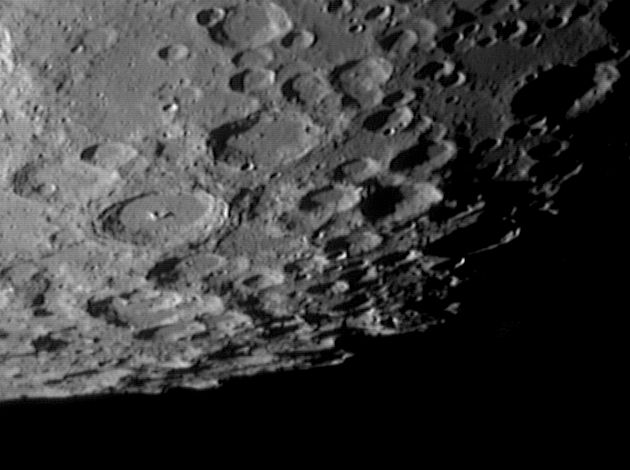
A closer picture of the south-polar area. The libration (-5° in latitude)
was quite favourable, so the South Pole is, in theory, visible. I have indicated
about where it is with an arrow pointing up the prime meridian.
The scale markers indicate approximately 50 Km north and east and apply at Moretus (which
is 117 Km in diameter). The north-south scale changes dramatically as one approaches
the south pole as does the direction of east.
The picture was taken with a ToUcam attached to my LX200 on 23rd September 2005 at 02:10 UT,
when the Moon was 20.1 days old.
Date and Time: 23rd September 2005 at 02:10 UT
Camera: ToUcam 740K
Telescope: LX200 with IR-pass filter
Capture: K3CCDTools. Low gamma, 1/25", 36% gain, 314 frames
Processing: Registax. 109 frames stacked. Wavelets 1 = 10, 2 = 5, gamma 1.3
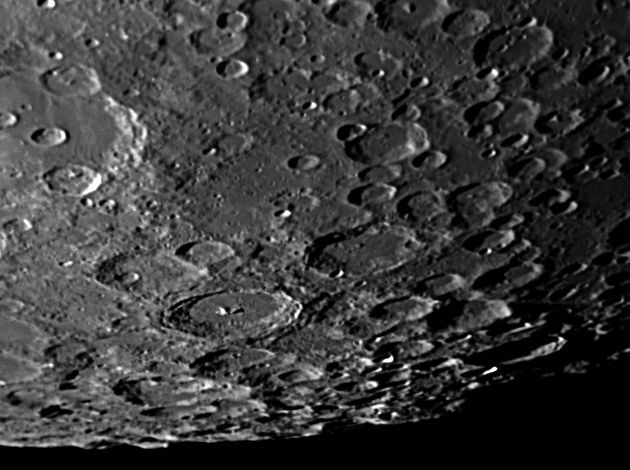
The same area again but with almost zero libration, and imaged with the DMK 21 camera.
Again one marker points along the prime meridian, which will be straight. The scale markers are approximately 50 Km west and north and apply at Moretus.
The picture was taken with a DMK 21 camera attached to my LX200 on 7th November 2009 at 04:34 UT, when the Moon was 19.5 days old.
Lunar Phase: 302.8°
Colongitude: 147.7°
Date and Time: 7th November 2009 4:34 UT
Camera: DMK 21AF04
Telescope: LX200 and IR-pass filter (>685 nm)
Capture: IC Capture. Gamma 10, 1/91", gain 564, 3454 frames
Processing: Registax. 79 frames stacked. Wavelets 1-2 = 5, gamma 0.7
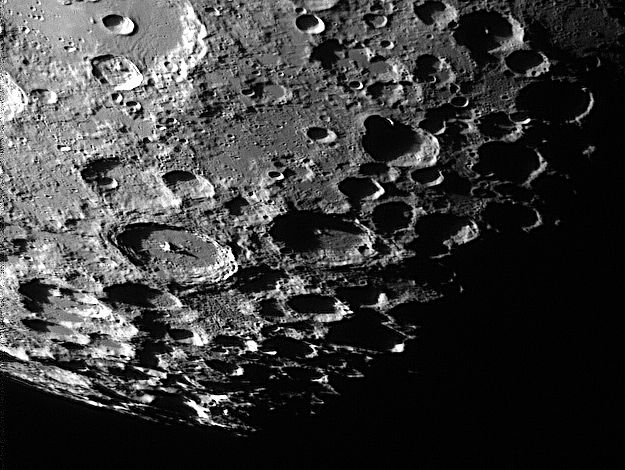
The same area again but with a libration in latitude of -4° 39', which tips the south pole into view. This can be seen by comparing Moretus and the area to its south in the two pictures. The libration in longitude is -6° 50', which tips the Moon to the left. Nevertheless the Sun was 20° lower in the lunar sky when this picture was taken compared with the one above.
Again one marker points along the prime meridian, which will not be quite straight. The scale markers are approximately 100 Km west and north and apply at Moretus.
I have a mosaic of this picture, with two to the north, here.
The picture was taken with a DMK camera attached to my LX200 on 31st August 2010 at 04:49 UT,
when the Moon was 20.6 days old.
Lunar Phase: 288.9°
Colongitude: 167.8°
Date and Time: 31st August 2010 4:49 UT
Camera: DMK 21AF04
Telescope: LX200 and IR-pass filter (>685 nm)
Capture: IC Capture. Gamma 10, 1/108", gain 716, 3366 frames
Processing: Registax. 100 frames stacked. Wavelets 1 = 10, 2 = 5, gamma 1.2
Focus Magic 1,100
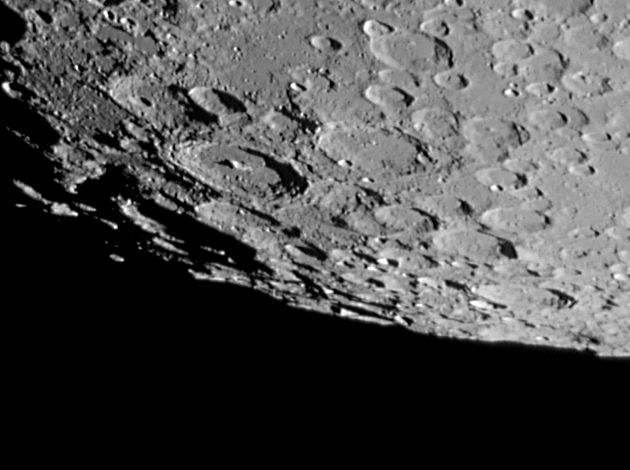
The same area as above but with the light coming from the other direction, but the libration in latitude is zero. The change in lighting has brought Scott partially into view.
Again one scale marker points along the prime meridian, which will not be quite straight as the longitudinal libration was 4°. The second marker is approximately 100 Km west and applies at Moretus.
The picture was taken with a ToUcam attached to my LX200 on 10th December 2005 at 17:13 UT,
when the Moon was 9.8 days old.
Date and Time: 10th December 2005 17:13 UT
Camera: ToUcam 740K
Telescope: LX200 with IR-pass filter
Capture: K3CCDTools. High gamma, 1/33", 19% gain, 545 frames
Processing: Registax. 136 frames stacked. Wavelets 1 = 10, 2 = 5, histogram 30-255
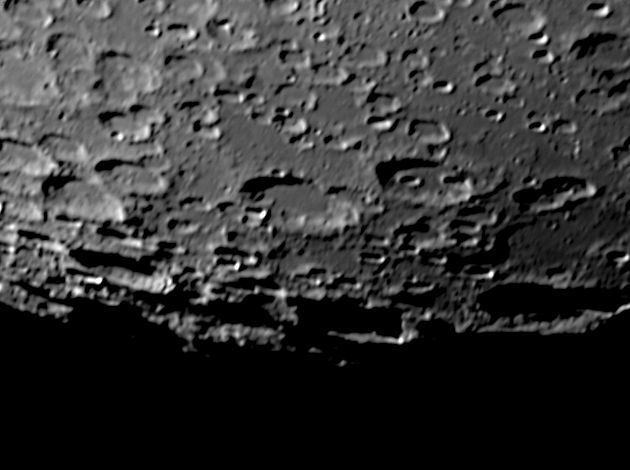
This is the area slightly to the east of the area shown above. It was taken at day 18.4 which is about 3 days before last quarter, so the Sun was low in the lunar sky. This means the edge of the Moon here is the terminator, not the limb; hence the deep shadows in Buguslawsky and Boussingault E.
The scale markers represent very approximately 100 Km north and west and apply at Manzinus. Remember, however, that scales and directions vary greatly for areas like this so close to the pole.
The picture was taken with a ToUcam attached to my LX200 on 10th September 2006, when the Moon was 18.4 days old.
Date and Time: 10th September 2006 22:00 UT
Camera: ToUcam 740K
Telescope: LX200
Capture: K3CCDTools. Low gamma, 1/100", 8% gain, 452 frames
Processing: Registax. 10 alignment points, 393 frames stacked. Wavelets 1-2 = 10, gamma 1.3
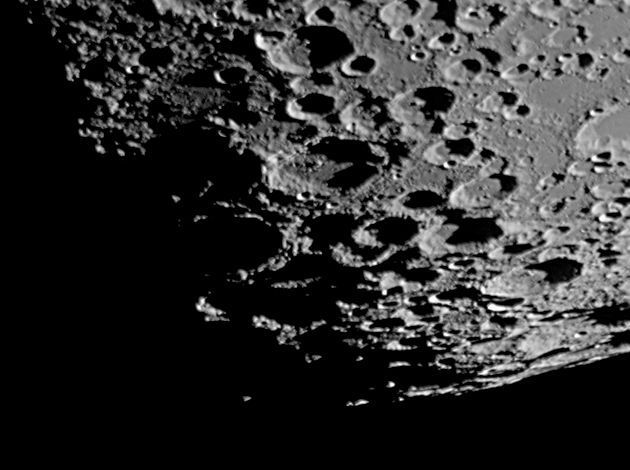
This is very much the same area as shown two pictures above, but the libration is very much more favourable at -5° 18' in latitude and 7° 12' in longitude. This tipped the south pole towards us, but unfortunately the solar angle was +0.5° so that theoretically the pole is not illuminated. However is sits on the ramparts of a small crater (named Shackleton after the British explorer who never reached the Earth's south pole) so the pole may be visible where I have indicated it on the mouseover. The libration does however improve our view of the craters named after two other famous antarctic explorers, Amundsen and Scott.
The scale markers represent approximately 100 Km north and east and apply at the western rim of Curtius.
The picture was taken with an Atik camera attached to my LX200 on 26th March 2007, when the Moon was 8.4 days old.
Date and Time: 26 March 2007 20:24 UT
Camera: Atik 1-HS
Telescope: LX200
Capture: K3CCDTools. High gamma, 1/100", 19% gain, 455 frames
Processing: Registax. 15 alignment points, 444 frames stacked. Wavelets 1-2 = 10, gamma 1.3 Home Back to SE Quadrant Back to SW Quadrant